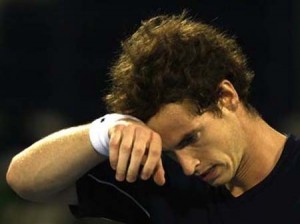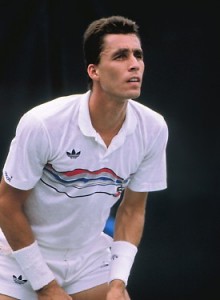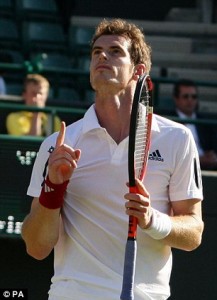Could Andy Murray’s Next Coach Be Tennis Legend Ivan Lendl?
These days Andy Murray walks onto the tennis court a defeated man, ready to receive the next dose of humiliation.
While this does not appear to be the case on the surface, mentally Murray appears to be in no man’s land—in danger of sinking completely from sight as he begins another journey onto the porous red clay of Europe.
Since he moved into the top five in September of 2008, the Scot has remained on everyone’s radar as they waited for him to make his move to the top of the men’s game. That meant winning a major and improving his ranking.
Many expected Murray to be the next No. 1 after Federer and Nadal, lauding his considerable talent.
Since 2008, Murray has held steadfast in the top four, except for a few intermittent weeks when he dipped into the five spot. Now, however, a steady diet of the No. 5 ranking has occurred since January of 2011, with Robin Soderling seemingly ensconced in the No. 4 spot.
Since making the finals of the 2011 Australian Open and losing to Novak Djokovic in straight sets 4-6, 2-6, 3-6, Murray has not won a match. The Scot was summarily dismissed in his opening round of play against Marcos Baghdatis at Rotterdam,
Receiving an opening round bye, the Scot lost his second round opener 6-7, 3-6 against American Donald Young at Indian Wells.
Murray followed with the same script in Miami, losing his second round opener to American Alex Bogomolov, Jr. who qualified to get into the main draw.
Murray has gone through coaches like Charlie Sheen goes through scotch, none being able to impose his will or his vision on the Scot for the long haul.
But now there are new overtures taking place. Tennis legend Ivan Lendl has apparently thrown his hat into the ring, stating that “Ivan the Terrible” can help Murray rescue his game and his career.
Just what can Lendl bring to Murray’s game? Consider that, to date, the two have followed similar paths toward a first “major” victory.
In the past three years, Murray has lost all three of his final slam appearances—two to Roger Federer at the 2008 U.S. Open and the 2010 Australian Open and one to Novak Djokovic at the 2011 Australian Open.
The Scot’s second and third losses, however, seemed to deflate his energy and his will to compete.
Lendl suffered a similar fate making the finals of the French Open in 1981, where he lost to the unbeatable Bjorn Borg on the red clay of Stade Roland Garros.
The next year, Lendl made the 1982 U.S. Open finals and lost to American Jimmy Connors. The Czech followed that by making the finals of the Australian Open in 1983 where he lost to Mats Wilander.
Making another U.S. Open final in 1983, Lendl lost once again—this time, to Jimmy Connors.
The press continued to hound Lendl. The accusation that the big-serving Czech could not win the big one wore on Lendl’s nerves.
Deep down, however, Lendl still believed he could win, and he dug down deep to find a way.
Extremely fit and forever unrelenting, Lendl realized he did not possess the natural talent held by many of his contemporaries. Consequently, the Czech had to be smarter and turn the match toward his strengths.
In 1984, Lendl found himself once again in the finals of the French Open against American John McEnroe. After losing the first two sets, Lendl had no choice but to go for it all in set No. 3.
McEnroe was killing him at the net. Lendl had to find a way to stop the American’s net hugging tendencies. The Czech began to lob and he kept lobbing, taking set No. 3 and then hanging on to win the last two sets.
In a classic match in which Lendl engineered a remarkable comeback, the Czech finally won his first slam after five tries, defeating McEnroe 3-6, 2-6, 6-4, 7-5, 7-5.
It took Lendl almost five and a half years to win that first major; the Czech was 24 years of age.
Lendl did so by playing consistent tennis from the baseline. He employed heavy topspin on his forehand and relished the opportunity to hit a running forehand either down the line or cross court, depending on his opponent’s position on the court.
Eventually, Lendl learned to hit his backhand with topspin. This enhanced his options, especially when he threw in lobs to keep his opponents off the net.
Similarly, it has been almost five and a half years since Murray turned pro. He will turn 24 in May.
At this point in time, there are definite similarities in their styles of play and their mindsets. Murray has all the weapons to win—all except, perhaps, self-belief.
As a counter-puncher, Murray loves to beat opponents at their game—using their power against them, waiting for them to self-destruct.
Critics have been quick to point out that Murray lacks the necessary drive to create his own game, to be on the attack and force the action.
Has the time finally come for the Scot to make a positive move instead of surrounding himself with “yes” men?
The two men share more in common than circumstances—they are both stubborn. But the difference lies in where that stubbornness takes them.
Murray is stubborn about having his own way. The Scot feels he is the best manager of his own tennis career.
Lendl was stubborn about perfecting his tennis and not letting anything interfere with his ability to win. Lendl hated to lose. But, he also understood what it took to win and he did whatever was necessary to achieve that objective.
This took Lendl to the top of the men’s game where he reigned for 270 weeks.
Murray could do far worse than employing Lendl to be his coach, but the Scot would have to understand going in that defying Lendl—yelling and screaming at the tennis legend—would be counterproductive.
Yet the image of the two dour countenances staring each other down brings forth images from a Tim Burton movie. It is crazy enough to work.
When Connors stepped out of the shadows to coach Andy Roddick, one always suspected that Connors was attempting to relive his career through the youthful Roddick.
Roddick, of course, did not have Jimmy’s volleying skills or his ability to move on the court. In the end, Connors discovered that he could only take Roddick so far—yet, not far enough. Roddick just did not have the natural tools to use against Federer, who was winning almost everything back then.
However, Murray does have the natural ability. What he lacks is the discipline that Lendl could certainly bring to bear.
It would be an interesting experiment to watch because ultimately, Murray needs the right pair of eyes guiding him out of the quagmire he seems currently stuck in.
Lendl could be the perfect guide for Murray.



Since jibing for some time for just a proper read in considers to this rather niche . Attempting in Bing I now spotted this internet site. Look this information So i am pleased to take that I have a very full depression I bumbled onto whatever I was ready for. I’ll make sure to don’t forget this website and commit it a look consistently .
The design for the weblog is a tad off in Epiphany. Nevertheless I like your weblog. I might need to install a normal web browser just to enjoy it.
Re: Whoever produced the remark that this was a good web site truly needs to get their brain reviewed.
Wow, superb weblog format! How long have you been running a blog for? you make blogging look easy. The entire look of your site is great, as well as the content!